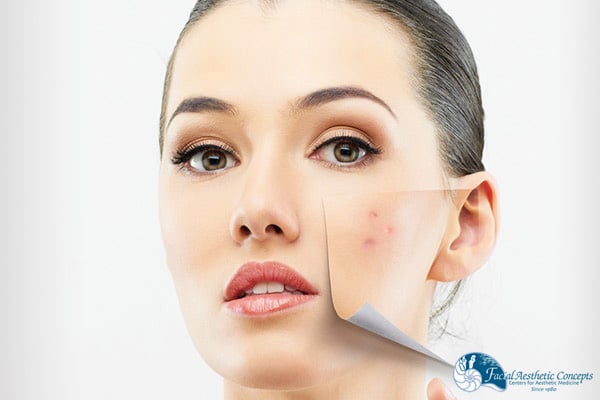What is a chemical peel?
Chemical peels are known as viable skin-resurfacing treatments that can be used for a wide range of conditions. Yet, many people have no clue what they are and if they’re safe and/or beneficial.
That’s why in this post we’re going to give you a detailed explanation so you can put your questions to rest.
What Are Chemical Peels and How Do They Work?
Essentially, the chemical peel is a method used to enhance and smooth the skin’s texture. This is done by a cosmetic dermatologist who utilizes an acid solution in order to remove dead and damaged upper skin layers.
The primary area that’s treated is the skin on your face and the main goal is to remove the outermost layers of the skin.
Chemical Peel Benefits

The primary benefits of using a chemical peel are associated with restoring a healthier and youthful appearance to your skin.
Some of the universal skin problems that are generally improved or even completely corrected by chemical peels are:
- Fine lines
- Wrinkles
- Acne
- Hyperpigmentation
- Rough skin
- Scars
- Sun-damaged skin
- Freckles
A study conducted by The Journal of Clinical and Aesthetic Dermatology back in 2010 is conclusive that chemical peels are indeed effective and even can be used as a viable method for treating lots of different conditions like melasma, photodamage, acne etc.
It should be noted that the internet is full of chemical peel before and after pictures and even videos. That speaks volumes about the obvious effectiveness of these procedures when it comes to rejuvenating and renewing your skin.
But in order to not be misled, the American Society of Plastic Surgeons suggests that you talk to your doctor to determine what is a chemical peel prior to a procedure. According to their recommendations, by doing so you’ll be able to get a good idea of what to expect in terms of post-chemical peel results.
Are Chemical Peels Safe?

As a general rule of thumb, chemical peels are safe. Side effects are rare and most of the people who have a chemical peel experience no adverse effects.
And patients who go through more powerful peels will require more time to recover. And the peeling and (or) crusting of their skin may be more noticeable.
These are some of the unwanted effects that a chemical peel can cause:
- Change in skin pigmentation
- Redness
- Infection
- Scarring
- Chemical burns (for people with darker skin)
- Damage to the heart, kidney and liver (due to the chemical “phenol”)
But you have to keep in mind that some of the aforementioned side effects are directly related to the particular class of chemical peel that was used.
There’s a relevant study by the Indian Journal of Dermatology, Venereology and Leprology, which after compiling data from 268 patients that underwent superficial chemical peeling came to a strong conclusion. Chemical peeling is a safe and well-tolerated treatment superficial facial conditions (like dermatoses).
Types of Chemical Peels

To truly understand what is a chemical peel, let’s look at the six distinctive types:
- Glycolic peel – comes in various amounts of concentration/strength and is best used for exfoliating and rejuvenating aging skin
- Lactic peel – derived from milk, this one is perfect for dry, sensitive skin and it’s also more gentle to the skin than retinol
- Beta peel – used to cure acne in younger and also older patients. Aids oil control, exfoliates the skin and targets the bacteria causing acne
- Vitalize peel – focused on improving the quality and to lighten the color of your skin. This peel is superficial, involves a very small amount of peeling and is ideal for someone who have never had a chemical peel before
- Pigment balancing peel – created to lighten the color of the skin. Getting rid of brown spots and reducing pigmentation takes time, so it’s important to have realistic expectations and to use a sunscreen for maximum effect.
- Trichloroacetic acid peel – provides a medium peel to the skin. This peel is utilized for removing abnormal skin cells and it provides great cosmetic benefits.
So depending on your skin type, the condition that you have and your expectations, your cosmetic dermatologist might pick one chemical peel type over the other. That’s done in your own best interest to ensure maximum efficacy of the procedure and to also minimize the chance of side effects.
What is a Chemical Peel? Your Answer to Blemished Skin!

Having a healthy, youthful and smooth skin is inarguably what every woman (and even man) wants. Chemical peels offer the perfect solution to an awful lot of superficial conditions and it’s been proven by science that it’s not only very potent, but it’s also safe at the same time.
That’s why at Facial Aesthetic Concepts, we offer not one, but a selection of chemical peels that are effective, affordable and we’re confident that you’ll love the look and feel of your skin after the procedures.
Feel free to check our dedicated Chemical Peel page. Also, our providers are available for peels from Monday to Saturday, so don’t hesitate to give us a call at 888-744-1828 and make your appointment now!
References:
Evidence and Considerations in the Application of Chemical Peels in Skin Disorders and Aesthetic Resurfacing
Your chemical peel consultation
Tolerance and safety of superficial chemical peeling with salicylic acid in various facial dermatoses